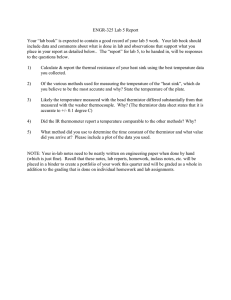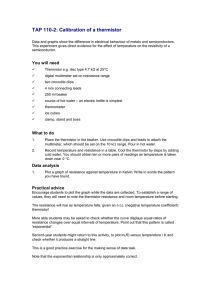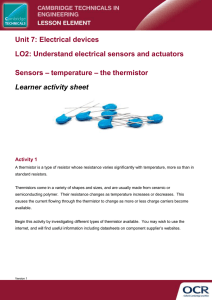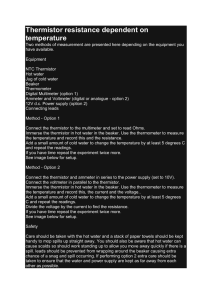Designing with Labview
advertisement
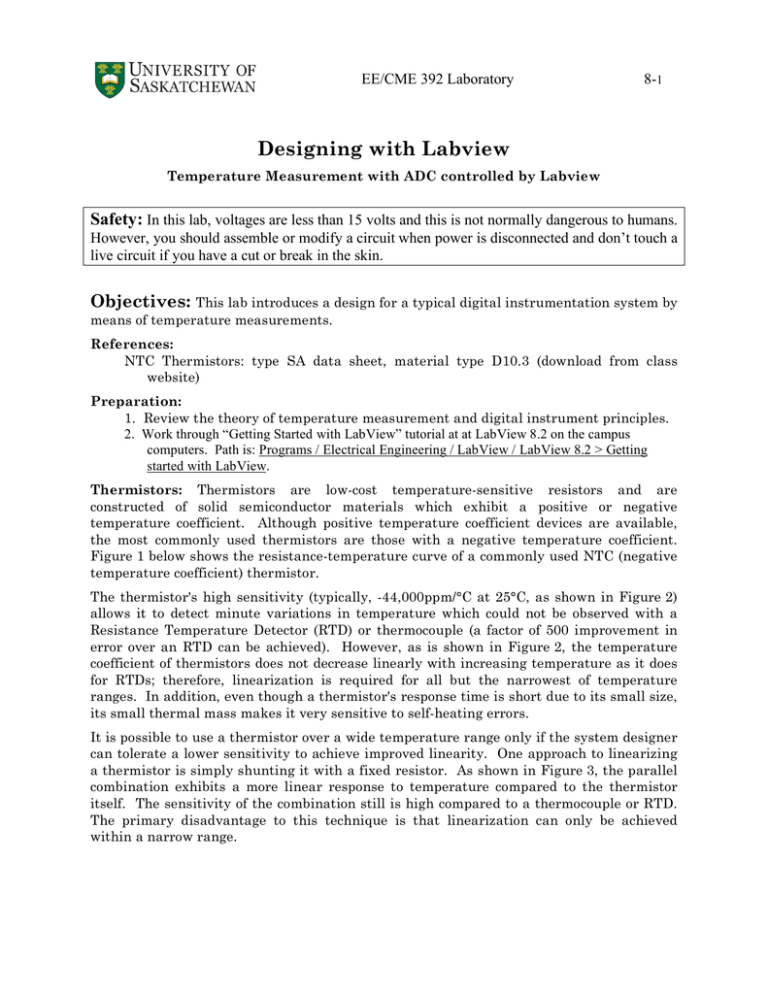
EE/CME 392 Laboratory 8-1 Designing with Labview Temperature Measurement with ADC controlled by Labview Safety: In this lab, voltages are less than 15 volts and this is not normally dangerous to humans. However, you should assemble or modify a circuit when power is disconnected and don’t touch a live circuit if you have a cut or break in the skin. Objectives: This lab introduces a design for a typical digital instrumentation system by means of temperature measurements. References: NTC Thermistors: type SA data sheet, material type D10.3 (download from class website) Preparation: 1. Review the theory of temperature measurement and digital instrument principles. 2. Work through “Getting Started with LabView” tutorial at at LabView 8.2 on the campus computers. Path is: Programs / Electrical Engineering / LabView / LabView 8.2 > Getting started with LabView. Thermistors: Thermistors are low-cost temperature-sensitive resistors and are constructed of solid semiconductor materials which exhibit a positive or negative temperature coefficient. Although positive temperature coefficient devices are available, the most commonly used thermistors are those with a negative temperature coefficient. Figure 1 below shows the resistance-temperature curve of a commonly used NTC (negative temperature coefficient) thermistor. The thermistor's high sensitivity (typically, -44,000ppm/°C at 25°C, as shown in Figure 2) allows it to detect minute variations in temperature which could not be observed with a Resistance Temperature Detector (RTD) or thermocouple (a factor of 500 improvement in error over an RTD can be achieved). However, as is shown in Figure 2, the temperature coefficient of thermistors does not decrease linearly with increasing temperature as it does for RTDs; therefore, linearization is required for all but the narrowest of temperature ranges. In addition, even though a thermistor's response time is short due to its small size, its small thermal mass makes it very sensitive to self-heating errors. It is possible to use a thermistor over a wide temperature range only if the system designer can tolerate a lower sensitivity to achieve improved linearity. One approach to linearizing a thermistor is simply shunting it with a fixed resistor. As shown in Figure 3, the parallel combination exhibits a more linear response to temperature compared to the thermistor itself. The sensitivity of the combination still is high compared to a thermocouple or RTD. The primary disadvantage to this technique is that linearization can only be achieved within a narrow range. EE/CME 392 Laboratory 8-2 Fig. 1 Resistance characteristics of a 10 KΩ NTC thermistor The value of the fixed resistor can be calculated from R= RT 2 (RT 1 + RT 3 ) " 2RT 1RT 3 RT 1 + RT 3 " 2RT 2 where RT 1 is the thermistor resistance at the lowest temperature in the measurement T1 range, RT 3 is the thermistor resistance at the highest temperature in the range T3 , and ! RT 2 is the thermistor resistance at the midpoint T2 = (T1 + T3 )/ 2 . ! The output of the network can be applied to an ADC to perform further linearization ! as ! shown in Figure 4. Note that the output of the thermistor network !has a slope of approximately -10mV/ o C, which implies ! ! that a 12-bit ADC has more than sufficient resolution. Fig. 2 Temperature coefficient of a 10 KΩ NTC thermistor EE/CME 392 Laboratory 8-3 Fig. 3 Linearization of NTC thermistor Procedure: 1. Using the schematic diagram in Figure 5, determine the interconnections of various components in the heater chamber provided in the lab. Identify the thermistors, the parallel resistor, the temperature sensing IC LM35 and the 51Ω heater. 2. Connect THERMISTOR output to ACH0 input of the DAQ Board, COMP THERMISTOR output to ACH1 input, the LM35 output to ACH2 and DIO0 from the DAQ to the control input. 3. Start LabVIEW on the computer. 4. Using various building functions in LabVIEW, plot the three voltage signals received from the three analog input channels. Apply power to the heater box. Provide the plots in your report. Draw conclusions from the plots. 5. Convert LM35 voltage readings to temperatures, and use them as the reference for voltage versus temperature plots for the two thermistors. During the experiment, save your ACH0, ACH1 and ACH2 data (i.e., voltages) sampled at temperature intervals of 0.5OC. Fig. 4 Linearized thermistor diagram EE/CME 392 Laboratory 8-4 6. Using saved data, plot voltage versus temperature for ACH0 and ACH1 in your report. Comment on the results. 7. In LabVIEW, setup a routine which sends out +5V to DIO0 in the DAQ when the temperature reaches 58OC in ACH2 and send out 0V when the temperature falls below 56OC. This signal will turn off the heater at 58OC and turn it back on at 56OC. Demonstrate the working control routine to your lab instructor. Questions: 1. Identify and discuss possible sources of errors in the temperature measurement used in this experiment (for all three measuring methods). 2. Did the resistance placed in parallel with the thermistor improve the linearity characteristic of the sensor? Why? 3. Revise and describe a method (with your schematic, block diagram, etc...) to linearize the NTC transducer (thermistor) for temperature measurements. EE/CME 392 Laboratory Fig. 5 Schematic diagram of the heater chamber and control 8-5
